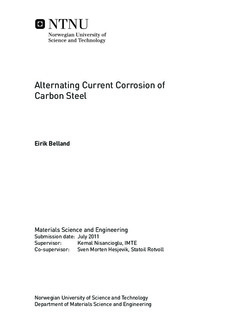| dc.description.abstract | The objective was to investigate if the established theory concerning corrosion calculations and electrochemical behavior of carbon is valid when steel is exposed to AC in an electrolyte consisting of 3,5 wt% NaCl and distilled water. The experimental work was divided in two main parts. The first part concerned corrosion testing, including weight loss measurements in stagnant conditions in combination with linear polarization resistance experiments. AC-current densities investigated was 0-, 50-, 75-, 100-, 150-, 220- and 500 A/m2. Polarization curves were produced on two weight loss samples, one exposed to 150 A/m2 and the other exposed to 220 A/m2, at the end of the weight loss experiments.From the corrosion testing it was found that the estimated corrosion current densities (icorr) from the weight loss experiments on samples exposed to AC-current densities below 500 A/m2, was in an approximate accordance with the icorr values estimated from LPR. At 500 A/m2 the measured corrosion rates and corresponding corrosion currents were slightly higher than the remainder. The higher corrosion rate measured from the samples exposed to 500 A/m2 is suggested related to a non-faradaic corrosion contribution. The suggested mechanism is a facilitation of grain boundary corrosion at high AC-current densities leading to the loss of grains. This being a non-faradaic corrosion contribution it is not possible to measure with LPR or polarization curves. The constant B [mV] from the Stern-Geary equation was estimated on basis of LPR measurements. The constant displayed a decreasing trend with increasing AC-current densities. This was explained by the lowering of anodic and cathodic tafel slopes with increasing AC-current densities. The polarization resistance (Rp - [Ω∙m2]) also showed a decreasing trend with increased AC-current densities. This was explained by the increased current response in the LPR measurements with increasing AC-current densities.The second part was intended to elucidate the effect of AC on electrochemical behavior of the carbon steel through producing polarization curves at different AC-current densities using a rotating electrode experimental setup. Alterations in corrosion current densities, cathodic tafel slopes, limiting current density of oxygen reduction and corrosion potentials on steel without AC and at current densities of 100-, 150-, 220- and 500 A/m2 are investigated during the electrochemical testing. From the rotating electrode experiments no significant change in corrosion current was found with increasing AC-current densities. The potential range, in which limiting current of oxygen reduction (ilim) appeared, decreased with increasing AC-current densities. This decrease in ilim also affected the corrosion potentials (Ecorr). A decrease in the potential range of ilim leads to a more cathodic Ecorr. A particular observation was found at AC-current densities of 150 A/m2 were the effect of ilim seemed absent. The samples exposed to this AC-current density also attained the most cathodic corrosion potentials at approximately -850mVSCE which was between 200-400mV lower than the samples exposed to the remaining AC-current densities. Cathodic tafel slopes showed a decreasing trend with increasing AC-current density. Anodic rafel slopes were considered absent due to pitting above Ecorr.Pictures of the weight loss samples were captured in the SEM. It was found that the formation of pits occurred on all weight loss samples exposed to AC. On the samples without induced AC no sign of pitting was observed. Hence it was found that the corrosion attacks attained a more local character when AC-current was induced in the steel samples. | nb_NO |

